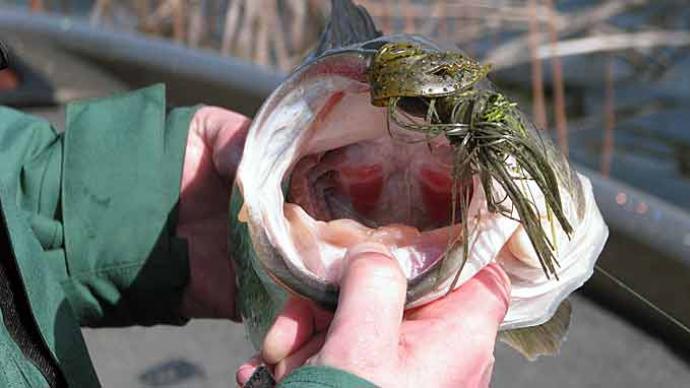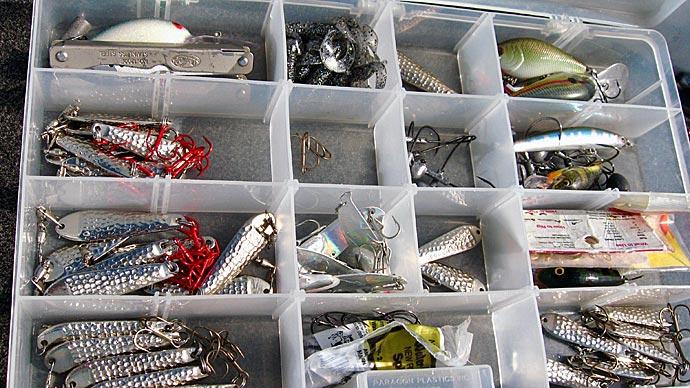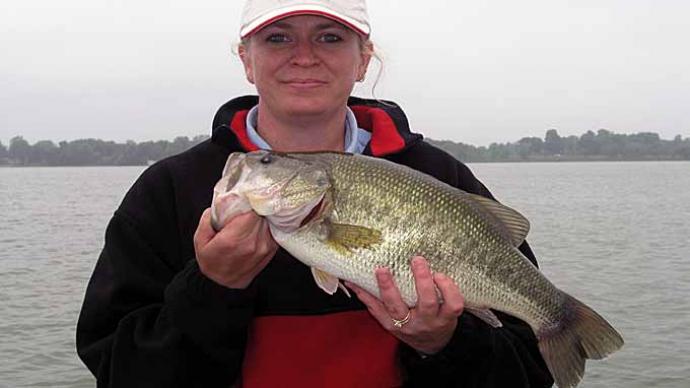
Most people are out deer hunting or preparing to do so, but November and December are also big bass times. Big females are on a feeding frenzy. They are moving around more, relocating their home areas, and putting on weight. Feeding periods will last longer this time of year. That, in turn, will put the odds in your favor for catching a trophy bass.
Bass will start showing up in tight schools. Some will contain large numbers of fish. These larger schools generally will contain smaller fish in the two-to five-pound range. Large bass will school in smaller groups. On Lake Fork (Texas) you can see groups of 5 to 10 fish in the 8- to 10-pound class, chasing gizzard shad and the big bass will be nearby.
To find schools of bass and baitfish you need a good depthfinder and you need to know how to interpret what you see. There are many good depthfinders on the market. If you do not know how to interpret your unit or adjust it to mark schools of baitfish or bass, read the instruction book. It will put you on the right track.
Start looking for schools of baitfish and bass at mouths of major creeks or over creek channels. Be on the lookout for surface activity. During fall and early winter, bass and baitfish use creek channels as highways. They move from the front to the back of major creeks. Make sure you keep your boat positioned on, or near, these creeks.
This pattern will continue until the water temperature reaches the mid 50's, then this feeding activity will slow down. Bass will still feed, but the feeding periods will be shorter and big bass will move shorter distances to feed as their metabolism slows. They can still be caught, but you need to slow down your presentation. Here in east Texas, and on many other Texas lakes, water temperature will not reach the mid-50's until the end of December.
For early winter, or until water temperature falls, think big lures for big bass. Now is the time to throw big soft and hard jerkbaits, AC plugs, Castaic trout, one-ounce Rat-L-Traps, and big spinnerbaits. One of my favorite baits is a 6-to9-inch Photofinish Sassy Shad on ¾-to 1-ounce jig head with a 7/0 hook. Throw these lures at suspended bass or bass chasing baitfish on the surface. For bass on the bottom, ½- to ¾-ounce jigging spoons, ½ to 1-ounce tail-spinner lures, and curly or flat-tail grubs on ¼- to ½-ounce jig heads are the best lures.
When water temperatures go below the mid-50's, a jig and pig and jigging spoon are hard to beat. Big bass will be on major points or in creek channels. Key in on areas that have feeding stations nearby. Major points, secondary points, ridges, and humps are your best bets. The closer they are to a major creek channel, the better. A lot of bass fishermen do not like fishing with jigging spoons because they do not have confidence in them, but I can assure you every day from October to mid-January the jigging spoon is one of the best producers of big bass.
When marking big schools of baitfish around a major creek channel, drop a ½-ounce, chrome-plated jigging spoon vertically to the bottom. Reel up the slack and suspend the spoon about two to six inches from the bottom. How you work the jigging spoon will depend on how deep the shad and bass are shown by your locator. When you see bass aggressively chasing baitfish on your locator, make a good 4- to 6-foot rod sweep up and drop back on controlled slack line. Be ready for the hit. If your jigging spoon stops falling, set the hook immediately! Be vigilant.
If baitfish and bass are holding near the bottom, use a 1- to 2-foot sweep of the rod. Normally when water is in the mid- to lower 50's you can suspend the spoon a foot or so off the bottom with no movement at all.
Good luck on your hunting. When you finish hunting, think about going after trophy bass. Winter is an excellent time to catch your dream bass.




